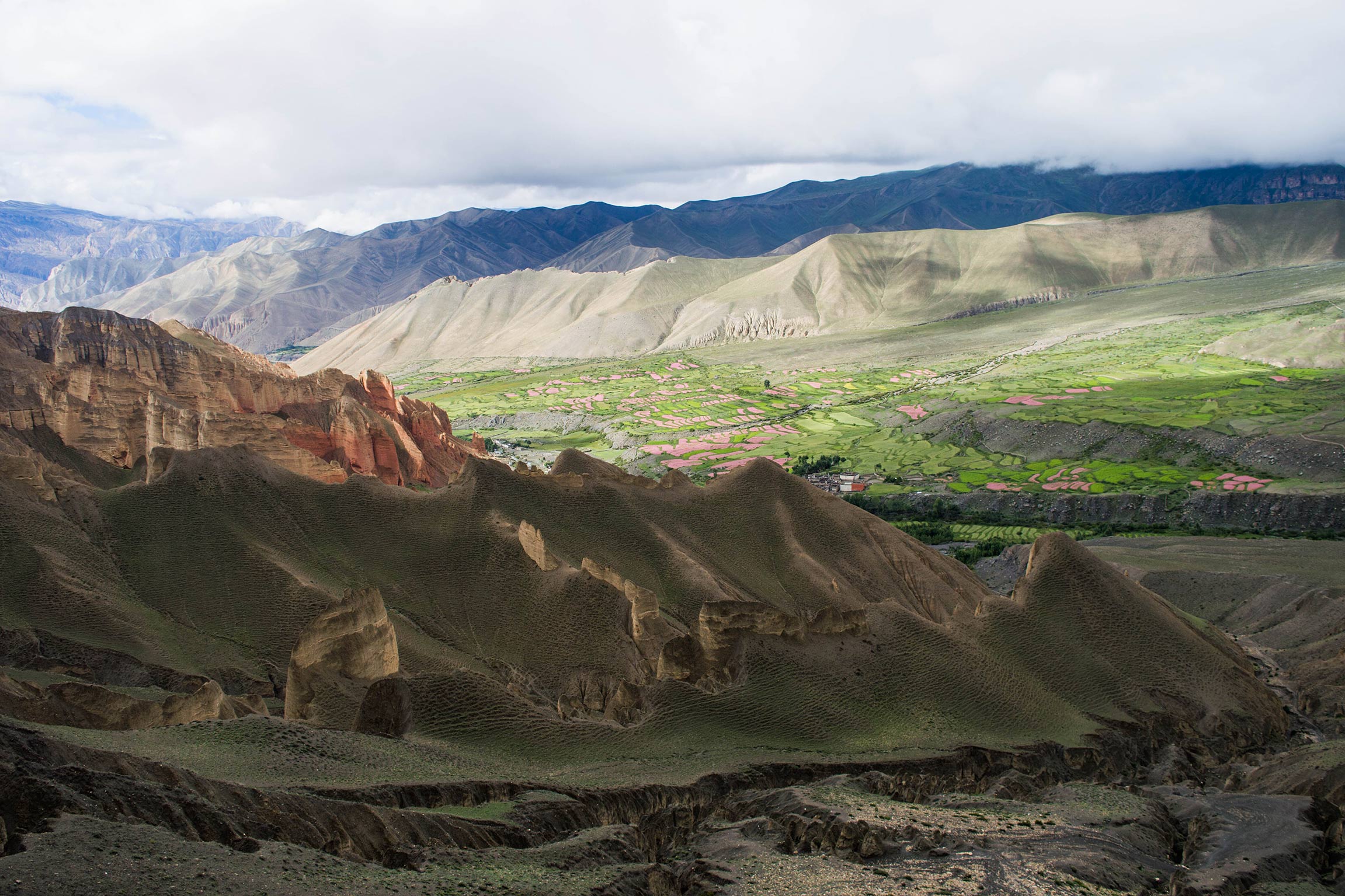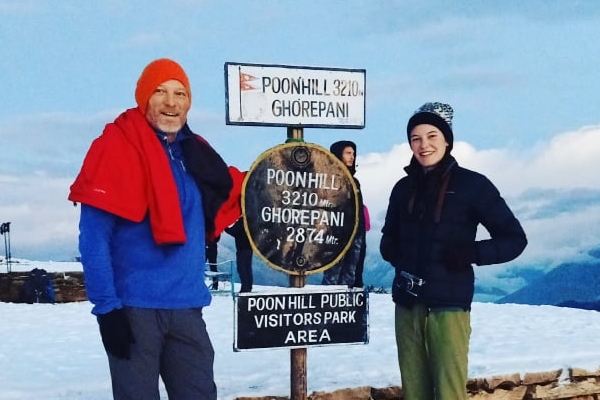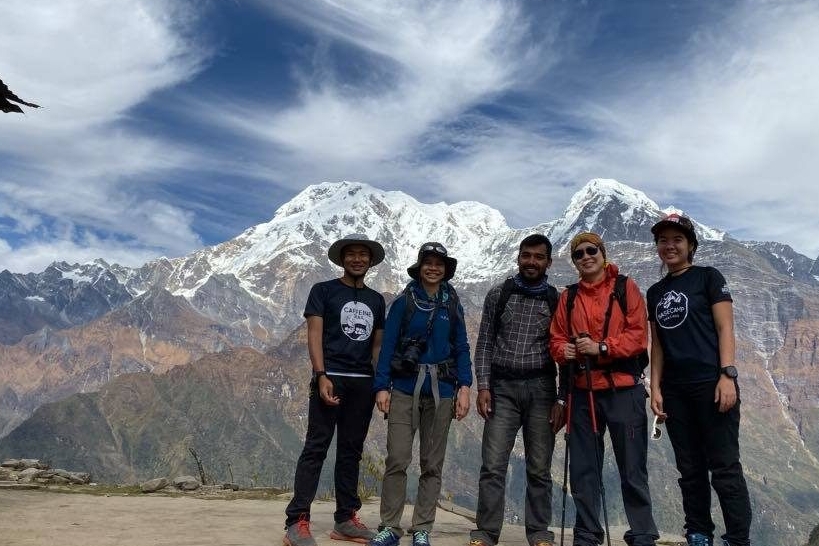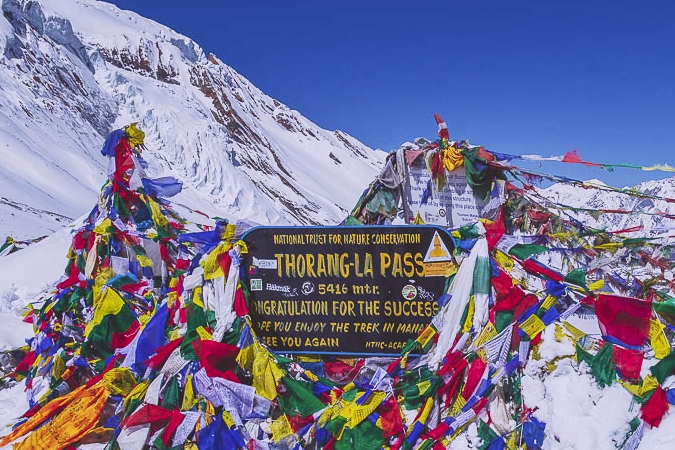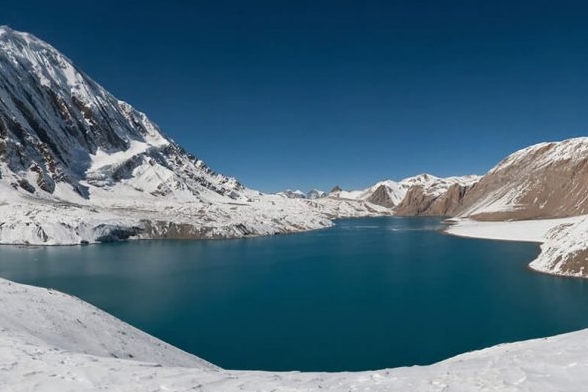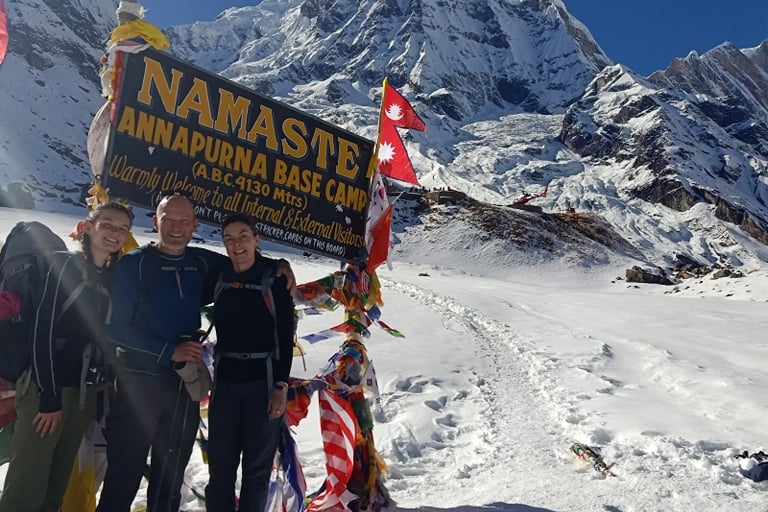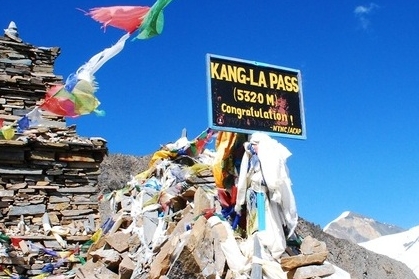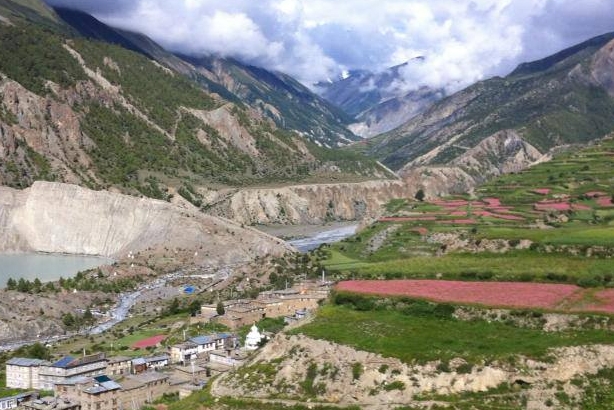"Experience the breathtaking beauty of the Himalayas and immerse yourself in the rich cultural heritage of Nepal on the legendary Annapurna Base Camp trek. Join our Annapurna base camp trek 2023/2024 departure and trek with native guides & porters. We have the best Annapurna base camp trek cost with top-notch service, guaranteed departure, and 100% safety assurance."
Nestled in the western reaches of Nepal, Mount Annapurna (8,091 m/26,545 ft) is the tenth-highest mountain in the world. The Annapurna base camp trek is a multiple-day hike through rhododendron forests and remote villages to the lap of Mt. Annapurna. If you're looking for a trek that truly showcases the beauty of the Himalayas, then the Annapurna Base Camp is definitely one to consider.
From the very start of the Annapurna base camp hike, you'll be surrounded by stunning Himalayan mountains, making it no surprise that this 13-day-long adventure is a popular choice for many travelers. One of the best things about the Annapurna base camp trekking is that it's suitable for all age groups and abilities.
Whether you're traveling with children or simply looking for a moderate trek, the Annapurna Base Camp trek in Nepal offers a comfortable walking experience with plenty of breathtaking scenery and cultural immersion.
As you ascend towards the Annapurna Base Camp via the Machhapuchhre Base Camp, you'll be rewarded with stunning views of the majestic Mt. Machhapuchhre (6,993 m/22,943 ft), Mt. Hiunchuli (6,441 m/21,132 ft), Annapurna South (7,219 m/23,684 ft), Annapurna I (8,091 m/26,545 ft), Annapurna III (7,555 m/24,787 ft), Mt. Gangapurna (7,455 m/24,459 ft), Mt. Nilgiri (7,061 m/23,166 ft), Mt. Dhaulagiri (8,167 m/26,795 ft), etc.
But it's at the Annapurna Sanctuary where you'll truly be blown away. Here, you'll enjoy a 360-degree panorama of the snow-clustered mountains, with a near-vertical view of the south face of the Annapurna towering above. And you will enjoy several gorgeous sunrises and sunsets during the Annapurna base camp trek 13 days.
As you trek through the Annapurna Conservation Area, you'll traverse a diverse landscape that includes verdant oak, pine, and rhododendron forests, and green rice paddies. Against the backdrop of misty valleys and rolling hills, the snow-capped peaks sparkle like diamonds. Along the Annapurna base camp trail, you'll come across picturesque Gurung and Magar villages and experience mountain life.
From the starting point of the Annapurna base camp trek at Nayapul (1,070 m/3,510 ft), the trail ascends to Poon Hill (3,210 m/10,525 ft) and continues to Annapurna Base Camp (4,130 m/13,550 ft). The elevation gain is high, so you have to be careful of altitude sickness and make sure to acclimatize properly.
The Annapurna base camp trek is considered a moderate trek in terms of difficulty, but it still requires a certain level of physical fitness and preparation. The Annapurna base camp trek route can be challenging at times, with steep ascents and descents. The trek involves crossing several suspension bridges over deep gorges, walking through lush forests, and climbing stone steps.
Altitude sickness can be a concern during the Annapurna base camp trekking, especially as you gain altitude. The base camp is at an elevation of 4,130 meters (13,550 feet), which can cause altitude sickness in some trekkers. Therefore, acclimatize properly and take rest days to adjust to the altitude. Drinking plenty of water, avoiding alcohol and smoking, and eating a balanced diet can also help prevent altitude sickness.
The Annapurna base camp trek in Nepal requires physical fitness and mental preparation. You should engage in regular exercise and cardio workouts for several weeks before the trek to build stamina and endurance. You can also do some hill walking and practice carrying a backpack to prepare for the trek.
Mental preparation is also important, as the trek can be mentally challenging too. You should be prepared for long days of walking and be able to handle the uncertainty and discomfort that comes with trekking in remote areas.
The Annapurna base camp (ABC) trek and Everest base camp (EBC) trek are two of the most popular treks in Nepal. Both of these treks offer a unique experience, with different landscapes, cultural immersion, and challenges.
The EBC trek is considered more challenging than the ABC trek. The altitude gain in the EBC trek is higher, and the trek requires more physical endurance and stamina. The ABC trek, on the other hand, is comparatively easier and is suitable for beginners.
The Everest base camp trek offers a chance to experience the unique Sherpa culture, including their traditional lifestyle and hospitality. Whereas, the Annapurna base camp trek offers a glimpse into the Gurung and Magar cultures, known for their rich traditions and hospitality. Likewise, both treks offer breathtaking scenery, but they are different in nature.
Nepal is home to hundreds of mountains, including the world's top 8 highest mountains. So, you can do base camp treks to those 8 eight-thousanders mountains. Apart from the Annapurna base camp and Everest base camp, you can do Manaslu base camp trek, the Kanchenjunga base camp trek, the Makalu base camp trek, and the Dhaulagiri base camp trek too.
Likewise, these are some of our other famous trekking packages in the Himalayas- Upper Mustang trek, Langtang Gosaikunda trek, Annapurna Circuit trek, Manaslu Circuit trek, Rara Lake trek, and Gokyo Lake trek.
Spring (March, April, May) and autumn (September, October, November) is the best time to do the Annapurna base camp trekking. Whereas, winter (December, January, February) and summer/monsoon (June, July, August) are the offtime for this trek. However, if you can put up with the additional challenges of the offseason, you can trek to Annapurna base camp in winter and summer/monsoon.
Although certain months of the year are more favorable for trekking in terms of weather, it's crucial to be equipped for all possible conditions, no matter when you plan to go. The unpredictable weather conditions in the high Himalayas can bring unexpected snowfall, rain, or storms at any time, and climate change has only made weather patterns more erratic in recent years.
In the mountains, it's always better to be over-prepared than under prepared, as the weather can change rapidly, and you may find yourself in challenging situations. Carrying essential trekking gear like a waterproof jacket, hat, gloves, and a warm sleeping bag is also a must.
The months of March, April, and May mark the arrival of spring in Nepal after the long, cold winter months. This colorful season is also considered one of the best times to embark on a trek to Annapurna Base Camp. The weather during springtime is perfect for trekking, as it's neither too hot nor too cold.
The average daytime temperature ranges from 16 to 22 degrees Celsius or 61 to 68 degrees Fahrenheit, with a drop of around 2 to 3 degrees Celsius or 27 to 28 degrees Fahrenheit during the night.
The autumn months of September, October, and November are considered the second best time to trek to Annapurna Base Camp. This season offers trekkers an excellent opportunity to experience clear, crisp skies with high visibility. The weather is dry, and the chances of rainfall are minimal, providing an unobstructed view of the breathtaking Himalayas.
During the daytime, the average temperature ranges from 16 to 22 degrees Celsius or 54 to 68 degrees Fahrenheit. The mornings and nights can be chilly, while the days are warm and sunny, making for perfect trekking weather. However, the nighttime temperature can drop to 25 to 27 degrees Celsius or 77 to 81 degrees Fahrenheit, so trekkers should be prepared with warm clothing.
The Annapurna Base Camp trek is a popular and challenging venture in the Annapurna region of Nepal. The trek difficulty is considered to be moderate. The ABC trek requires a good level of fitness, as you will be trekking for around 10-12 days and ascending to an altitude of 4,130 meters (13,550 feet) at Annapurna Base Camp.
The trail can be steep and rocky in some sections, and you have to prepare for 5 to 6 hours of walking each day. Despite the standard challenges, the Annapurna base camp trek is suitable for most people with a good level of fitness and some trekking experience.
The trek begins through lush forests and terraced rice paddies, passing through traditional villages and remote mountain communities. As you ascend higher, the terrain becomes more rugged, with rocky trails and steep switchbacks leading up to Annapurna Base Camp. The trek is mostly on well-maintained trails, but some sections can be rocky and uneven, requiring good trekking boots and trekking poles.
Likewise, you may have heard about altitude sickness or acute mountain sickness. If not, usually trekkers suffer from this during high-altitude trekking like the Annapurna base camp. Symptoms of altitude sickness can include headache, nausea, dizziness, and shortness of breath.
To prevent altitude sickness, you have to acclimatize properly by ascending slowly and taking rest days as needed. Drink plenty of water, stay hydrated, eat a balanced diet, and avoid alcohol and smoking.
Annapurna base camp trek is a lodge trek. Lodges serve as a much-needed break, offering comfortable housing and a variety of amenities at an affordable price. Typically established and run by local residents. Many lodges are strategically located at points along the trail where travelers can acclimate to the altitude and immerse themselves in the local communities.
These humble accommodations typically offer wooden beds fitted with basic mattresses, pillows, and blankets. Guests can also enjoy the warmth of a Bukhari-style stove for heating, savor meals in communal dining areas, and even participate in lively musical performances using traditional instruments.
The lodges lining the Annapurna Base Camp trail offer a tempting array of meals, with a menu that boasts an impressive range of options such as Dal Bhat, Momos, Spaghetti, French Fries, and more. If you're wondering what to order, your guide will likely recommend the hearty and nutritious Dal Bhat, which packs a whopping 430 calories per serving.
If you are planning to do the Annapurna Base Camp trek in Nepal, you will need to obtain two types of permits: the Annapurna Conservation Area Permit (ACAP) and the Trekkers' Information Management System (TIMS) card. You can obtain a TIMS card through a licensed guide, so trekking alone is no longer possible in Nepal.
●As of 2021, the fee for the ACAP permit is NPR 3,000 (approximately USD 25).
●As of 2021, the fee for the TIMS card is NPR 1,000 (approximately USD 8.50).
If you are planning to do the Annapurna Base Camp trek in Nepal, it is highly recommended that you purchase travel insurance. Travel insurance will provide you with peace of mind and financial protection in case of unforeseen events such as illness, injury, flight cancellations, or other travel-related mishaps.
Make sure that the insurance policy you choose provides adequate medical coverage. Look for a policy that covers emergency medical evacuation, hospitalization, and other medical expenses. You can also get coverage for trip cancellation or interruption, which can protect you if your trip is canceled or interrupted due to unforeseen events such as a family emergency, illness, or severe weather conditions.
You will need a valid passport to enter Nepal. Your passport must be valid for at least six months from the date of your arrival in Nepal. If your passport is expiring soon, it is recommended that you renew it before applying for a visa.
Nepali travel visa is available on all entry borders, including the Tribhuvan International Airport. You can also apply for a visa at a Nepalese embassy or consulate in your home country before your trip. The visa fee varies depending on the length of your stay in Nepal. As of 2021, the fee for a 15-day visa is USD 30, a 30-day visa cost is USD 50, and a 90-day visa cost is USD 125.
●A valid passport
●One passport-size photo
●Completed visa application form (which can be obtained online or at the airport)
●Visa fee (which can be paid in cash or by credit card)
Travel tips for the Annapurna base camp trek
●Luggage: We provide a duffel bag to every trekker to pack their heavy trekking clothes and gear. Make sure to keep your weight under 10 kg. Likewise, you can carry a daypack with you to keep the necessary items with you on the trail. Store any additional luggage in the hotel's locker room free of cost.
●ATM: There is no ATM on the Annapurna base camp trail, and the locals do not accept payments through cards. You will need some Nepali rupees for personal expenses during the trek. So, withdraw enough money in Kathmandu.
●Internet: To stay connected to your family, opt to purchase a Namaste SIM card for 4G connections, which tends to provide a more reliable and speedy connection than lodge’s Wi-Fi. However, it's worth noting that even with a SIM card, you may still encounter areas with poor or no signal.
●Charging: Many lodges at higher altitudes rely on solar energy for lighting and power. While this is generally a sustainable and reliable source of energy, it can be impacted by poor weather conditions, particularly during the rainy and winter seasons. To ensure you're not left in the dark and to keep your devices charged, we advise you to bring along a reliable torch light and power bank.
●Tips: Our ABC trek cost does not cover tips for guides, porters, and drivers. If you are happy with their service, feel free to tip them as you wish.
●Hot Shower: Hot showers are available at some lodges along the trekking route, but they often come at an additional cost and may not always be reliable. Wet wipes will come handy.
●Drinking Water: It's essential to drink plenty of water while trekking to prevent dehydration and altitude sickness. Bottled water is available along the trekking route, but it's not always reliable or environmentally friendly. A better option is to bring your own water bottle and use water purification tablets to treat the water before drinking.
●Personal Expenses: You will need extra money to buy services like internet, hot shower, charging, drinks, etc during the trek. Our Annapurna base camp trek cost covers all accommodations and meals. However, you have to pay for any additional service used during the trek. Likewise, you will also need a separate budget for internal light flights, travel insurance, tips, shopping, etc.
1.Headache
2.Dizziness
3.Loss of appetite
4.Breathing problem
5.Nausea or Vomiting
6.Fatigue or weakness
7.Persistent speedy Pulse
8.Drowsiness
9.trouble sleeping
Arrive in Kathmandu at any time. Our airport representative will welcome you and explain the program further. There are no planned activities for the day, so check into the hotel. Evening welcome dinner with cultural show.Overnight at hotel.
You may use flight which takes 25 min and can use private Tourist Vehicle. Via Tourist bus Its take 6-7 hour’s .Evening boating at Fewa Lake and sightseeing near the lake area. Overnight at hotel.
Trek from Pokhara (915 m.) to Nayapul (1050m.) by car, which takes approximately one and half hours drive. Now you begin your trek from Nayapul (1050m.) to Ulleri(2070m) . Via Birethanti (1065m.) which takes about four hours. The first part of your trek is easy passing through numerous small villages and settlements. O/N at Ulleri.
Today we heading to Ghorepani.First we need to climb steeply for the early 2 hours and then ascend gently passing through and Banthanti, Magar villages. On the way, can see good view of Machhapuchhare or Fish Tail (6997m.), Hiunchuli (6441m.), and Annapurna (7219m.)O/N at Ghorepani.
Early morning trip to Poon Hill (3210m.) to enjoy the sunrise view over Mt. Dhaulagiri (8167m.), Tukuche Peak (6920m.), Nilgiri (6940m.), Varaha Shikhar (7847m.), Mt. Annapurna I (8091m.), Annapurna South (7219m.), Annapurna III (7855m.), Machhapuchhare (6993m.), Annapurna IV (7525m.), Annapurna II (7937m.), Lamjung Himal (6931m.) and other numerous snowcapped mountain peaks. After breakfast trek Ghorepani to Tadapani (2650 m.). After walking for almost one and half hour you reach Gurung Hill which has the splendid mountain views as Poon Hill. From here you follow small forests with rhododendron, bamboos until you reach Deurali. The trail goes steeply down through deep forests all the way to Banthati. It takes one hour from here to reach Tadapanil After breakfast trek from Ghorepani to Tadapani (2731m.) through the deep forests of rhododendrons, bamboos and oaks. En route, you frequently see waterfalls, rocks, wild animals, local birds and green scenarios. Tadapani is a small village surrounded by beautiful forests which grants you a magnificent view Himalaya. Treks from Ghorepani to Tadapani its take around 5 hours. O/N at Tadapani
Trek from Tadapani to Sinuwa and it takes about four hours. It is very easy trek by ascending gently all the way through rhododendron, oak and other kinds of dense forests. You could hear different kinds of birds chirping on the way. O/N at Sinuwa.
We are heading to Deurali which takes five hours. You trek gently ascend through forests with varieties of rhododendron and oak trees. The first town you reach is Dovan (2630m.) where there are few lodges and camp sites then we head to Deurali. O/N at Deurali.
Wake up early in the morning then trek to Annapurna Base Camp.We begin our exciting trail towards Machhapuchhre Base Camp. Firstly we walk ascend gradually and steeply over the mountain side. The trek to MBC to Annapurna Base Camp is a bit strenuous but the spectacular vista of Machhapuchhre rewards our trail very enjoyable. We reach MBC by early afternoon then after our trail continues climb until we reach Annapurna Base Camp. Our trek enables to see the snow boulders melting and forming small streams. We will have sensation views of the near vertical south face of Annapurna towering above the sanctuary. Annapurna Base Camp sanctuary boasts of a dynamic view without anything impeding panorama of the 360 degrees. We will have interesting view of Machhapuchre, Annapurna south, Annapurna I, Hiuchuli and other peaks. Enjoy a warm night’s sleep in comfortable at Annapurna Base Camp.O/N at Base Camp.
We trek from Base camp to Bamboo which takes 6-7 hours. From the Annapurna base camp we retrace our steps to Bamboo. Today’s trek is downhill so it shouldn’t be very difficult. Besides, we will always have the company of the extraordinary landscape to cheer us up. Overnight in Bamboo.
Today we trek to Jhinu Danda which takes 5-6 hours. We continue our trek from Bamboo to Sinuwa then move down and get to Lower Chhomrong. From Lower Chomrong our trail takes ascending on the thousand stony steps and we reach upper Chomrong then we trek down to Jhinu Danda. We can enjoy hot spring while staying in Jhinu Danda. Overnight in Jhandu Danda at hotel.
On our way to Naya Pull from Jhinu Danda we get to enjoy the amazing hill landscape of western Nepal. We will have a lunch on the way. Our trek will end at Naya Pul where we board our vehicle to Pokhara. Overnight in Pokhara.
Drive from Pokhara to Kathmandu by a tourist bus – 6hours. Optional: can use fight which takes 25 min. but cost will be more then this price O/N at Kathmandu Hotel.
Approximately 3 hours before your scheduled flight, a representative from the Nepal Adventure Pilgrimage, will take you to the airport and bid you farewell. You will take with you wonderful memories of a truly outstanding experience
We trekked with Anil for 2 weeks in January 2020. It was the most incredible trip we have ever had. Anil took such great care of us and went the extra mile every day to point things out and really did take our trip to the next level. We had been in touch with him over many months planning a trek to the Gokyo Lakes. We had worked with him to arrive on this trek as we didn’t want something too well trodden but also were trekking with our 17 year old daughter so didn’t want anything risky. When we got to the airport to fly out to Lukla all the flights were cancelled and looked like they might be for several days. Within an hour Anil had come up with another trek and booked it in with a new porter, flights, car transport... the whole itinerary!! We were off to do the Annapurna Base camp. He really saved the day. It was the most beautiful experience walking through ferny valleys and icy mountains, in the snow and sunshine. Walking in winter was fantastic as it was low season and so what would have been super busy in summer was peaceful and beautiful. Anil pointed out so many extra little things along the way. He constantly checked in to see if we wanted to rest, and changed the schedule to fit in with our needs. He carried my husbands day pack as well as his own full pack when my husband was a bit unwell. We are so grateful that we found Anil and would recommend him for anything that you want to do anywhere in Nepal. We are hoping to go back in a few years to do Mustang with him.
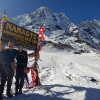
It was a pleasure to have Nepal Adventure Pilgrimage Treks and Expedition as our guide to ABC. Anil took care of us very well and was (and still is!) a great guide and friend to us all during the whole trip. Even when we arrived back in Kathmandu, he still offered us a good price transport around town as well as suggestions about everthing there. It was a memorable trip and I wouldn't hesitate to go with them again next time around.
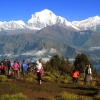
We did the Annapurna base camp trekking with Anil 2022 and we're very fortunate. Super friendly and very knowledgeable of the trekking and it's different short cuts and places. With Anil by your side one has only to focus on walking and enjoying the breathtaking surroundings. Definetily recommend him and his companyNepal Adventure pilgrimage Trek . if your searching for a serious and very good company. Excellent value for money

This is my first time coming to nepal. Im quite nervous and lost at the same time when im landed at the airport. But luckily Anil the manager was always ready to respond to my question. The accomodation and transportation was all well planned by him. On day 2 i am to leave kathmandu to pokhara and hike up to my first lodge stay at the same day. Met my guide Bhabanath Adhikari at pokhara airport and they drove me up to the starting point. And there after everything was nicely organised. Breakfast, lunch and dinner are all serve by my guide and he constantly checking up on me if i need anything or if i need him to slow down on his pace. You know nepalis who live in the mountain are rumoured to have 3 lungs unlike me who live in the comfort of my city haha. For those first timers who want to explore nepal, be it mountain or their nature park, i highly recommend you to go for their service and look for Bhaba to be your guide if you are into mountain climbing.

Yes, you will get the airport pick up and drop off services available. Our airport representatives will receive you at the airport and transfer you at the hotel in Thamel. Evening is free for you to explore the eateries and bars of the area. Our office will complete all your trekking formalities. Overnight in Hotel.
You can obtain your VISA to Nepal either by contacting our embassy or consulate office in your host country. There is a provision of VISA on Arrival to the tourists. As you land in Nepal you can fill up the form and pay the VISA charge at the International Airport in Nepal.
You can get accommodation of your choice in Kathmandu and Pokhara. These two cities are the major touristic destinations of Nepal. Therefore, you can get accommodation of different categories ranging up to 5 star.
Yes, you can extend your stay in Pokhara. However, if it is not included in your regular itinerary you will have to pay extra as per the services. The set flights or bus tickets; if needs to be changed, the incurred extra charges must be paid by yourself.
Yes, you can upgrade accommodation in Kathmandu and Pokhara. However, it is subjected to be charged extra as per the prior trip agreement.
The distance between Kathmandu and Pokhara is 200 km. There are numerous side roads and it is along the Prithivi Highway. The traffic is high. Therefore, traffic jam may result in the hours of road trip. However, the normal time to reach Pokhara by bus or tourist bus is about 6 – 7 hours.
Yes, you can fly to Pokhara instead of driving. And it takes about 35 - 45 minutes. Please contact the travel planners if you have already booked the road trip. The price of the flight and road trip is subject to availability and the current rates category.
Yes, it is safe to fly from Kathmandu to Pokhara. Moreover, there is null number of air accidents on this route.
Accommodation in Annapurna Base Camp Trek is in teahouse or lodge. In some places trekkers can get the attached bathroom but most of the time the room is in the general category and have common bathroom without private attached.
You can get the diverse food/meals during the trek to Annapurna Base Camp. If you prefer to have the western menu, then also you can have it. However, try some local delicacies which might help you to understand the local lifestyle too. If you don’t want to try the locals, then the Annapurna base camp trek route offers general western menus.
You can get the boiled or filtered water in the teahouse which you can fill up the bottle according to the price. The drinking water for the locals is okay if they drink from natural spring water but you can refill it and use the purifying pills.
In most of the teahouses, you will get the western commode style toilets. Don’t expect the toilets of all the amenities. But remember you don’t have to defecate in the public. The condition of bathroom is of Spartan way.
Hot shower is subjected to be paid extra. However, in some teahouses you can get free shower. But remember to consult with your guide before doing the shower.
Spring and Autumn is the best time to Annapurna Base Camp Trek. However, trekkers can do the trekking in either winter or in summer season in Nepal. Please remember that summer season coincides with the monsoon time in Nepal. During this time of the year the cloud blocks the vision of the mountains and it might be frustrating for some. But remember that during off season the trail is tranquil and there won’t be many trekkers.
It is up to you to decide to do the trekking of your liking. Private or Group Trekking, the level of the services and the hospitality we provide is same. Therefore, choose according to your liking.
We can arrange the trekking for maximum 50 people as there would be shortage of teahouses for the group more than 50 people. However, for the tour there won’t be any problem.
Yes, it is possible for the beginners too but remember every trekkers must have the sound physical condition as the Annapurna Base Camp Trek reaches up To 4130 m from sea level which involves the trail with uphill and downhill.
Yes, it is attainable by children but before the trek please mention the age of the trekkers to our travel planners so that we can amend the itinerary. For the children below 18 years old, it is recommended to have the guardian. However, we can arrange the trek or tour for kids too on the basis and guidance of their guardians.
It is a moderate trekking trail but every age group of trekkers can do the trekking. However, we can customize the trekking itinerary as the per the group characteristics.
We can avoid the altitude sickness during the trek by following the instructions of the guide. You have to walk uphill or higher altitude slowly and uniformly. Please remember to have plenty of fluids either water or soupy food. Proper acclimatization in your itinerary can also help you avoid the altitude sickness.
Yes, Foreign Money is accepted on the trail but the currencies which are not accepted by Nepal Government is not accepted.
Yes, It is mandatory to have the travel insurance during the Annapurna Base Camp Trek. You need to have the insurance plan which covers the Helicopter rescue, accidents, and medical expenses.
Yes, it is necessary to make a down payment to confirm the trip to Nepal with us. You will have to make at least 20% of the trip cost.
This Trek requires preparations and checklists of gears & equipment needed for the journey. It is always best to carry the essential clothing and accessories for the entire trek. We understand that you have your own preference for clothing but we recommend you to consult us before packing.
